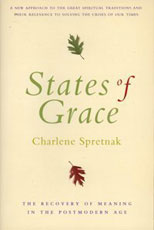"While some people work to "cosmologize" organized religion, others have taken to grow-your-own ceremonies of cosmological celebration, especially at the solstices and equinoxes. The two days with the longest and shortest gift of light from our sun, plus the two days with light and darkness of equal length, plus the midpoint days between those four were celebrated in pre-Christian Europe as natural markers in the majestic cycles of Earth's body. Two of the midpoint holy days are preserved in modern times as May Day and All Saints Day (or All Hallows Day, preceded immediately by Hallows Eve, or "Halloween"). Today the solstices and equinoxes have become occasions for groups of friends and family to gather in celebration of the Earth community and to focus awareness on the particular turning of the seasons. With friends, I have given thanks at autumn equinox for the bountiful harvests of the soil and in our lives, turned inward on the long night of winter solstice to look directly at the dark, known regeneration at spring equinox as Earth's exuberance burst forth, and felt the fullness of fruition at summer solstice when Earth's day is long and sensuous.
"Of all those images, the most beautiful that remains with me is the spring equinox ritual we evolved over time. A group of some forty people in spring colors walk from our cars in procession to a gentle rise in a spacious park, carrying armfuls of flowers and greens, food and drink, and burning incense. Musicians among us play instruments as the children toss a trail of petals. We form a circle and place the flowers and greens at our feet, forming a huge garland for the Earth, one foot wide and half as high. In the center on colorful cloths we set baskets of food and objects of regeneration — feathers shed by eagles and other birds, a bowl of water, a small statue of a pregnant female, and several sprays of pink and white blossoms. We breathe together and plant our feet squarely on the warming earth, drawing up its procreative powers into our being. Working mindfully, we take some flowers and ivy from the Earth garland and make individual garlands with trailing ribbons for ourselves, then weave together the stems and greens in the grand garland. Standing, we call upon the presence of the East and the cleansing winds that clear our minds. We call upon the presence of the South and the fires of warmth and energy that enliven us. We call upon the presence of the West and the water that soothes and renews us. We call upon the presence of the North and the earth that grounds and feeds us. We sing, perhaps the Indian song "The Earth Is Our Mother." We seat ourselves around the garland and offer into the circle one-word poems about spring in our bioregion. Someone reads a favorite poem. A storyteller, accompanied by soft drumming and bird-song flute, tells an ancient tale of the meaning of spring. We sing a lilting song with her. A second storyteller tells another story of spring. We sing a rhythmic chant with him. The two bards put on masks they have made and dance and leap around the circle, sprung with vernal energies. In counterpoint, the men sing his song, the women hers. We rise and sway like saplings as we sing. We move as the spirit moves us, dancing, turning. When we come to rest, we sit, emptied of song, on the ground and let the flute song fill our bodies. We pass around a bowl of berries, each person taking one and offering into the circle thoughts of thanksgiving for particular gifts of spring. Brimming with love for the embodied wisdom of Gaia, we bid farewell to the presence of the four directions and break the circle. Then come feasting and visiting. Thus do we welcome spring."
